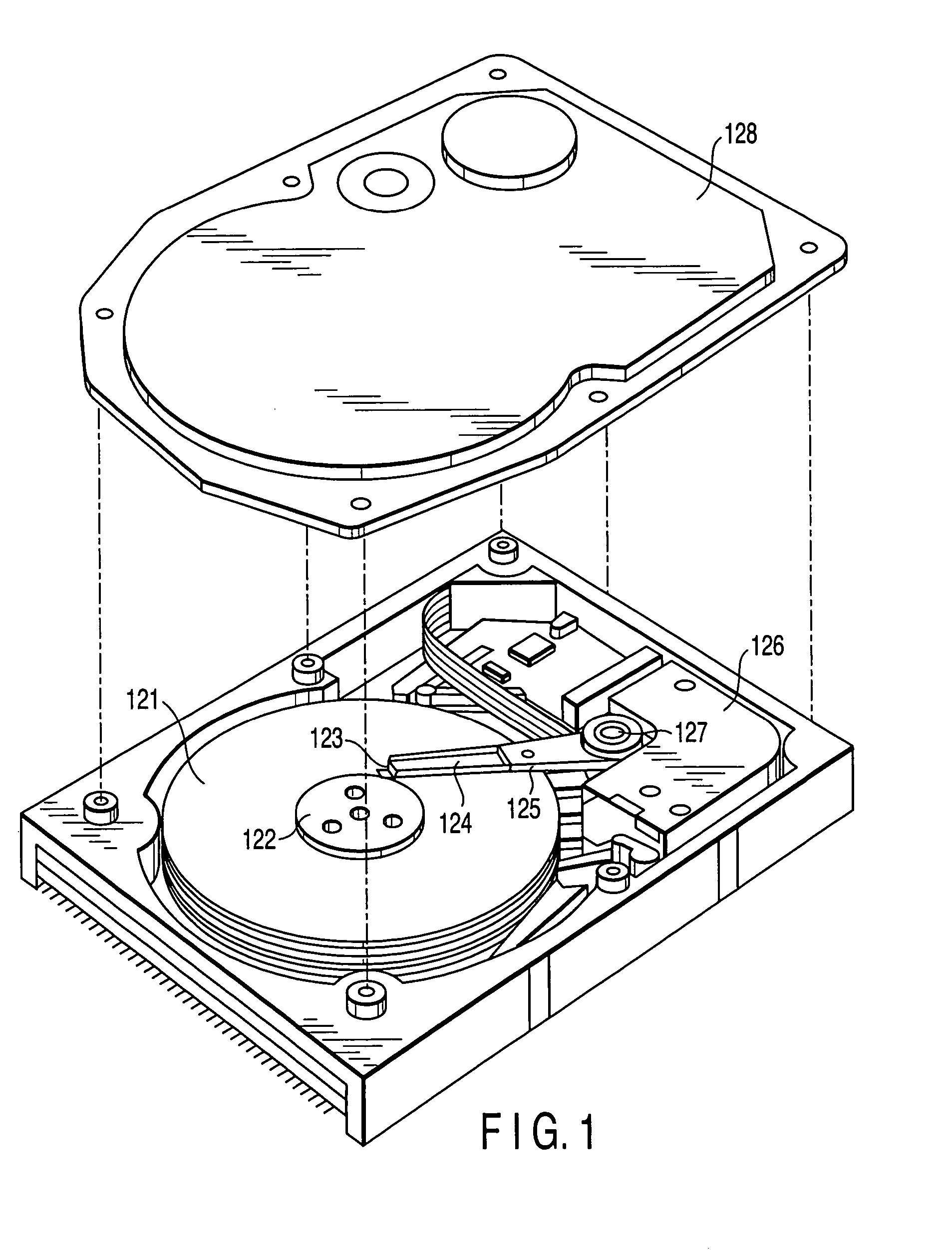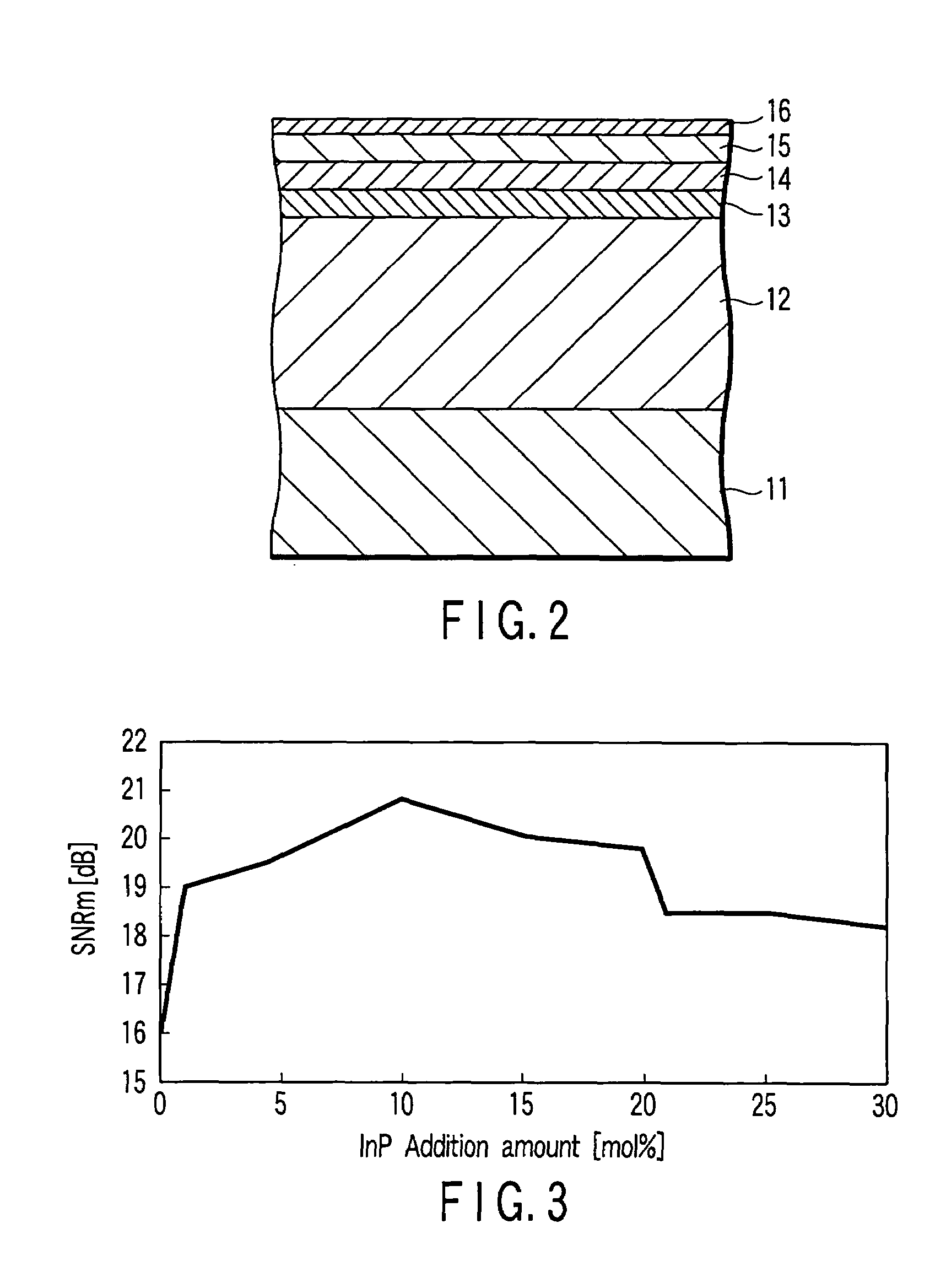Perpendicular magnetic recording medium, method for manufacturing the same, and magnetic recording/reproducing apparatus
a technology of magnetic recording medium and manufacturing method, which is applied in the field of perpendicular magnetic recording medium, method for manufacturing the same, and magnetic recording/reproducing apparatus, etc., can solve the problems of increasing the noise generated by the medium, increasing the recording density, and reducing the recording quality
- Summary
- Abstract
- Description
- Claims
- Application Information
AI Technical Summary
Benefits of technology
Problems solved by technology
Method used
Image
Examples
embodiment 1
[0060]A 2.5-inch, hard-disk-like nonmagnetic glass substrate was prepared.
[0061]After a vacuum chamber of a sputtering apparatus was evacuated to 2×10−5 Pa or less, a 200-nm thick Co84Zr6Nb10 soft magnetic layer and 8-nm thick Ta layer were formed as a soft magnetic layer and first underlayer, respectively, in a 0.67-Pa Ar ambient by using a Co84Zr6Nb10 target and Ta target, respectively. After that, a 15-nm thick Ru layer was stacked as a second underlayer in a 3-Pa Ar ambient.
[0062]Subsequently, a 20-nm thick magnetic recording layer was formed by using a composite target obtained by adding 0 to 30 mol % of InP as a matrix material to Co-10 at % Cr-14 at % Pt as a magnetic crystal grain material. A 7-nm thick C layer was then stacked as a protective layer in a 0.67-Pa Ar ambient. After the film formation, the surface of the protective layer was coated with a 13-Å thick perfluoropolyether (PFPE) lubricating agent by dipping, thereby obtaining a magnetic recording medium. The electr...
embodiment 2
[0081]A 2.5-inch, hard-disk-like nonmagnetic glass substrate was prepared.
[0082]After a vacuum chamber of a sputtering apparatus was evacuated to 2×10−5 Pa or less, a 5-nm thick Ta layer was formed as a first underlayer in a 0.67-Pa Ar ambient. After that, a 15-nm thick Ru layer was stacked as a second underlayer in an 8-Pa Ar ambient.
[0083]Subsequently, a 15-nm thick magnetic recording layer was formed in an 8-Pa Ar ambient by two-target simultaneous sputtering by using a Co-10 at % Cr-14 at % Pt target as a magnetic crystal grain material and an InP target as a matrix material. During this sputtering, the electric power to be applied to each target was so controlled as to appropriately change the addition amount of the matrix material between 0 and 30 mol % with respect to the magnetic crystal grain material. A 7-nm thick C layer was then stacked as a protective layer in a 0.67-Pa Ar ambient. After the film formation, the surface of the protective layer was coated with a 13-Å thic...
embodiment 3
[0094]A 2.5-inch, hard-disk-like nonmagnetic glass substrate was prepared.
[0095]After a vacuum chamber of a sputtering apparatus was evacuated to 2×10−5 Pa or less, a 200-nm thick Co84Zr6Nb10 soft magnetic layer, 5-nm thick Ta layer, and 15-nm thick Ru layer were formed as a soft magnetic layer, first underlayer, and second underlayer, respectively, in a 0.67-Pa Ar ambient by using a Co84Zr6Nb10 target, Ta target, and Ru target, respectively.
[0096]Subsequently, a 10-nm thick magnetic recording layer was formed in an 8-Pa Ar ambient by two-target simultaneous sputtering by using a Co-10 at % Cr-14 at % Pt target as a magnetic crystal grain material and an InP target as a matrix material. During this sputtering, the electric power to be supplied to each target was so controlled as to appropriately change the addition amount of the matrix material between 0 and 30 mol % with respect to the magnetic crystal grain material. A 7-nm thick C layer was then stacked as a protective layer in a...
PUM
 Login to View More
Login to View More Abstract
Description
Claims
Application Information
 Login to View More
Login to View More - R&D
- Intellectual Property
- Life Sciences
- Materials
- Tech Scout
- Unparalleled Data Quality
- Higher Quality Content
- 60% Fewer Hallucinations
Browse by: Latest US Patents, China's latest patents, Technical Efficacy Thesaurus, Application Domain, Technology Topic, Popular Technical Reports.
© 2025 PatSnap. All rights reserved.Legal|Privacy policy|Modern Slavery Act Transparency Statement|Sitemap|About US| Contact US: help@patsnap.com



